3D 프린팅








COVID-19의 확산으로 인해 현재 겪고 있는 긴급 상황을 감안할 때 코로나 바이러스, 특히 의료 장비 및 개인 보호 장비(PPE)의 부족을 완화하기 위해 연대와 혁신에서 훌륭한 이니셔티브와 솔루션이 등장하고 있습니다.
3D 프린팅에서 분야에는 의료 전문가와 함께 화장실의 건강을 보존하고 작업을 용이하게 하는 PPE(개인 보호 장비) 모델을 설계하기 위해 노력하는 많은 엔지니어와 재료 제조업체가 있습니다. 의료 장비 부족을 완화하는 데 도움이 되는 밸브, 호흡기 또는 보조 호흡기의 커넥터 및 기타 장치.
또한 많은 제작자 커뮤니티 이러한 장치를 제조하기 위해 3D 프린터를 출시했습니다. 스페인에서는 수천 명의 자원 봉사자가 있는 비영리 플랫폼인 Coronavirus Makers 이니셔티브가 등장했습니다. 독일, 이탈리아, 칠레, 아르헨티나 또는 콜롬비아와 같은 국가에서도 유사한 이니셔티브를 찾을 수 있습니다.
아래에는 여러 회사 및 협회에서 대중에게 무료로 제공하고 STL 형식으로 다운로드하여 거의 모든 FDM 프린터로 인쇄할 수 있는 보호 장비 및 의료 용품의 다양한 디자인을 정리했습니다.
일부 모델은 해당 보건 당국에 의해 승인 또는 승인되지 않았으며 각 지역 또는 국가에 따라 이 승인을 얻기 위한 제조 요구 사항이 다를 수 있음을 염두에 두어야 합니다.
3D 프린팅 리소스 플랫폼과 3D 분야의 다양한 기업 페이지에서 다양한 마스크 모델이 모든 유형의 3D FDM 프린터에서 3D 프린팅을 위해 공유되고 있습니다.
이러한 마스크는 , 필요한 필터가 있다는 점을 제외하면 바이러스에 대한 물리적 장벽 역할만 합니다. , 감염된 경우 확산되지 않도록 도와줍니다.
며칠 전 우리는 Copper3D에서 개발한 Nanohack 마스크의 디자인을 공유했습니다. 단일 블록 구조, 강력하고 밀폐된 NanoHack 2.0이라는 마스크의 디자인 업데이트를 최근에 공유한 팀 , 외부 환경에 대해 최대한의 보호를 제공하기 위해 PLActive 및 MDFlex 항균 필라멘트로 제조되어야 합니다.
PLActive는 항균 특성을 보이는 구리 나노복합체를 포함하는 재활용 가능하고 생체 적합성 폴리머입니다.
디자인 덕분에 NanoHack 2.0 공기 중의 입자로부터 보호하고 기도를 오염시키는 액체의 확산을 방지하는 장치입니다. NanoHack은 여과 시스템으로 수술용 마스크(부직포 폴리프로필렌)에 사용되는 것과 동일한 재료를 사용합니다. 최적의 보호를 위해 3중 폴리프로필렌 부직포 필터를 사용하는 것이 좋습니다. 이 필터는 마스크에 내장되어 있습니다. 따라서 다양한 연구에 따르면 1미크론의 미생물에 대해 96.4%, 0.02미크론의 미생물에 대해 89.5%의 여과 효율이 달성됩니다.
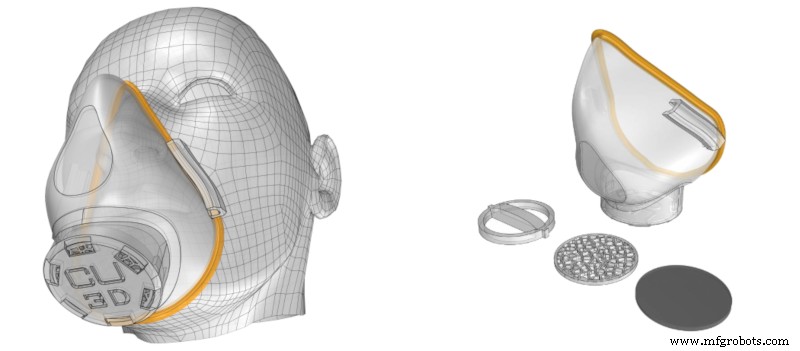
추가 정보
STL 다운로드
수많은 바이저 및 안면 보호대 모델을 찾을 수 있습니다. 인터넷에서. 프루사 has developed several prototypes, which have been verified with the Czech Ministry of Health. Finally, they have presented two screen versions:RC1 and RC2.
 This screen design consists of a rigid structure with a flexible and transparent acetate plastic sheet. The rigid structure is 3D printed and the plastic acetate sheet is then adapted as a screen. The RC1 version allows more parts to be printed in the same printing process, while the RC2 version provides slightly higher protection and is more comfortable to wear.
This screen design consists of a rigid structure with a flexible and transparent acetate plastic sheet. The rigid structure is 3D printed and the plastic acetate sheet is then adapted as a screen. The RC1 version allows more parts to be printed in the same printing process, while the RC2 version provides slightly higher protection and is more comfortable to wear.
As a screen, the prototype uses a 0.5mm thick PETG sheet, although other transparent and flexible materials with a similar thickness can be used such as clear acetate sheets.
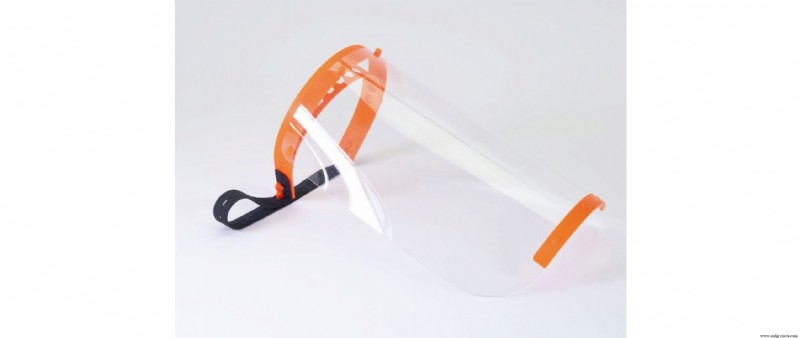
More info
Download STL from Prusa
3D printing with PETG with 30 % fill is recommended, although other materials such as PLA or ABS can be used. In order to deliver them to health centers, it's essential to sterilize them by applying a water bath with bleach (Ratio 50:1) and then rinse them with water. In this way, they will not carry the risk of possible indirect transmissions for healthcare personnel.
Given the shortage of self-contained respirators, several groups of engineers, in collaboration with different institutions and healthcare personnel, are developing prototypes and manufacturing the different parts that compose them using 3D printing.
This is the case of the Barcelona Free Trade Zone Consortium that, together with HP, Leitat, and SEAT, have developed a prototype of a respirator using 3D printing to manufacture its parts and taking advantage of elements such as a car's windshield wiper motor. This device has been named OxyGEN and has already been validated by experts from the Parc Taulí hospital in Sabadell. One of the advantages of this device is that its production is scalable.
Another possible solution that arises is to use adapters that allow the same respirator to be used for several patients, such as the “H” connector that Copper3D has developed. A design that minimizes dead space volume and prevents possible air leakage due to unnecessary connections. Copper 3D recommends 3D printing of this device using PLActive, for its antibacterial properties and biocompatibility.
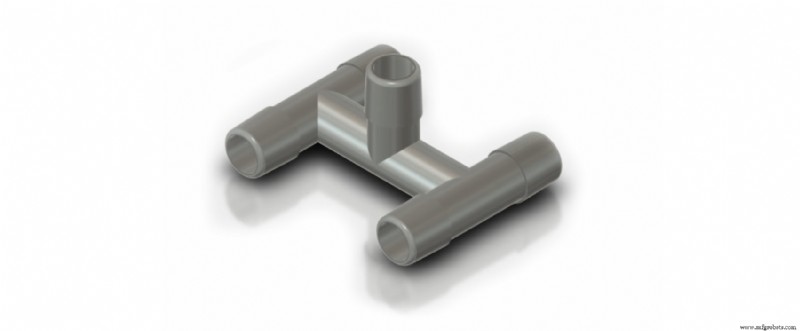
Más información
Download STL
In several hospitals there is a lack of some important elements related to respirators and necessary when treating a patient with respiratory complications. This is the case of the Venturi valve , used to regulate the oxygen concentration that is introduced to the patient through the respirator.
There are several designs available to users, such as this one from the Cults platform.
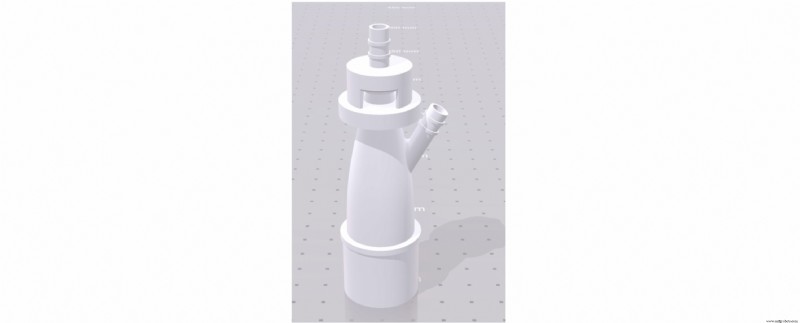
Download STL from Cults
In addition to PPE and specific devices for the treatment of patients affected by COVID-19, different tools are being developed to avoid the contagion by indirect contact to which anyone is exposed in their daily activity (door and window handles, buttons for elevators, etc.).
The StopCovid-19 ring is an easy to print ring, designed to press switches and buttons without physically touching them.
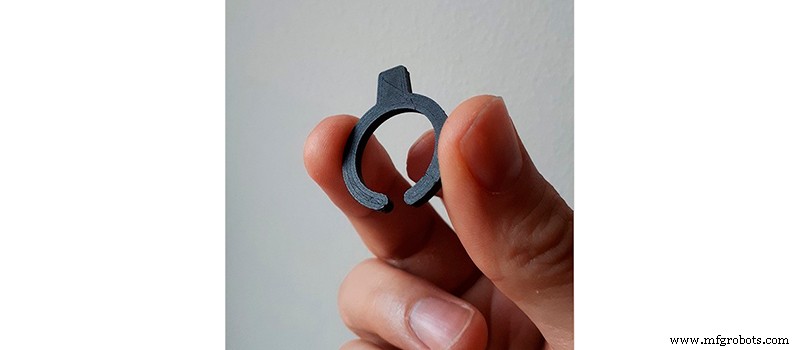
Download STL from Cults
Companies like Materialise have developed a device for attaching to door handles, so that they can be opened without using your hands. Different versions of this tool, adapted to different handle formats (cylindrical, rectangular, circular, etc.) can be downloaded free of charge from its website.

Download STL from Materialise
Combining the usefulness of the previous two, there is LU-Touch :A tool for opening and closing doors and windows, and at the same time a push-button for buttons and switches. LU-Touch can be downloaded for free and printed on any 3D FDM printer. In addition, if you do not have a 3D printer, it can be purchased already printed.
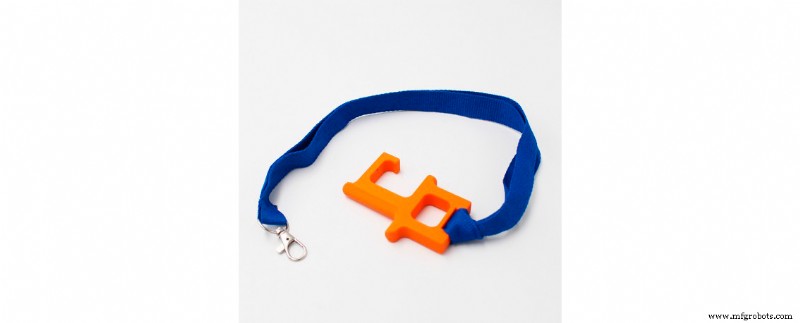
Download STL from Thingiverse
Thanks to the use of these tools, it's possible to minimize the possibility of contagion due to indirect contacts in daily activity. For greater safety, it's necessary to disinfect the tools always after use. It should also be remembered that the use of this type of tool does not exempt from applying the recommended safety rules:wash your hands regularly, do not touch your face, etc.
Among the specific materials to manufacture personal protective equipment, we highlight PLActive and MDFlex for their antimicrobial and antiviral qualities. This material is also recommended for printing expansion devices and valves adapted to self-contained respirators.
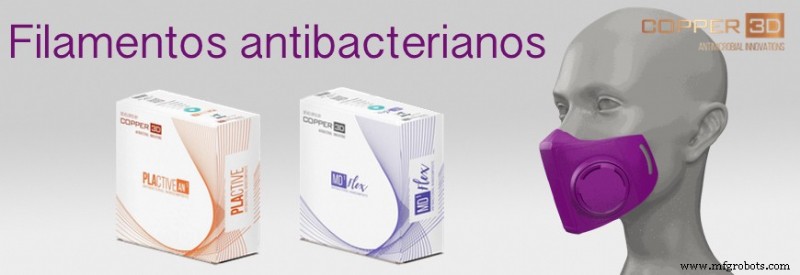
For the manufacture of screens or valves that, due to their use, do not need to be composed of biocompatible or antibacterial materials, basic materials can be used in 3D FDM printing, such as PLA or PETG; since these elements do not require specific properties, although it's true that they require some rigidity and it's not recommended to use flexible materials such as Flexfill or FilaFlex.
With these free download files, any user with a FDM 3D printer and any of the aforementioned materials can contribute their bit to help stop the pandemic and the alarming situation we are currently experiencing.
3D 프린팅
3D 프린팅 기술은 많은 장점을 제공하지만 이를 사용하는 데 있어 주요 관심사 중 하나는 비용입니다. 설계에서 제조 및 사후 처리에 이르기까지 몇 가지 트릭이 비용에 상당한 영향을 미칠 수 있습니다. 이 문서에서는 3D 프린팅 비용을 절약하는 데 유용한 팁을 강조합니다. 3D 프린팅의 각 단계에서 비용 절감을 위한 팁 이 부분은 3D 프린팅 프로세스의 여러 단계와 프로세스를 가능한 한 저렴하게 만들기 위한 팁을 기반으로 세 부분으로 나뉩니다. 시작합니다. 디자인을 통한 비용 절감 3D 모델 중공 재료를 덜 사용하고 비용을 줄
파이프가 자동으로 스스로 고칠 수 있다면 어떨까요? 금이 가거나 부러지거나 옷이 날씨나 사용자가 하는 활동에 따라 변경될 수 있는 경우 ? 스스로 조립하는 가구, 성장에 적응하는 보철물... 이것들은 4D 프린팅 기술이 실현할 것으로 예상되는 응용 분야 중 일부에 불과합니다. 이미지 1:모양을 수정하는 4D 프린팅 발톱. 출처:Sculpteo. 3D 프린팅 거의 30년 동안 존재해 왔으며 여전히 연구 과정에 있는 동안 새로운 재료 및 응용 프로그램, 4D와 같은 새로운 기술이 등장했습니다. MIT 자가 조립 연구소에서 ,